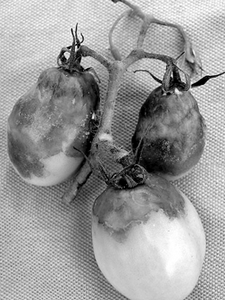Subscriptions
Menu
Advertisements
Late blight 101: Get ready now
4/28/2010 |
By Patsy Nicosia |

If last summer’s late blight devastated your tomato crop, now’s the best time to prevent a repeat appearance.
Late blight is a fungus that’s difficult if not impossible to stop once it arrives; it thrives in cool, wet conditions—like last June’s.
And if the “wet weather stars align” again, Cooperative Extension Agriculture Program Leader David Cox said he’s worried it will be back.
“If we have anywhere near the level of moisture we had last year, we risk an equally devastating spread of infection and crop loss,” Mr. Cox said.
Though late blight is historically spread by spores dispersed by the wind, in ’09’ it came directly from tomato plants sold by big box stores and then quickly spread to potatoes as well.
Chuck Bornt leader of Cornell’s Capital District Vegetable & Small Fruit Team, said this year’s prevention efforts are focusing on potatoes.
The late blight fungus can’t over-winter on its own, but rather needs a live host, Mr. Bornt explained.
While end-of-summer advice talked about the need to remove and throw away—not compost or even burn—all diseased tomatoes and foliage, he said the real threat now comes from potatoes that were left in the ground.
“Any tubers left in the ground, that’s where the emphasis needs to be now,” Mr. Bornt said. ‘Don’t compost them; put them out with the garbage. Otherwise, we could see the same sort of devastation.”
Barbara Waring, a Master Gardener for the local Extension, also stressed the need to make sure last summer’s left-over garden debris is cleaned up.
‘There’s still a lot they don’t know about it,” she said.
Ms. Waring suggested treating gardens preventatively with fungicides, pointed out the need for good drainage and space between plants, and said it would be a good idea to look for seeds and plants identified as late blight-resistant.
Mr. Bornt agreed the last suggestion is a good one, but went it one further.
“There aren’t that many late blight-resistant varieties available to the backyard gardener,” he said.
“I’d suggest buying your plant from someone local or a reputable grower who you trust. It was the big box stores who were responsible for last year’s nightmare.”
Other suggestions Mr. Bornt had were to water plants from the base—not the top—and to avoid locating gardens in the shade.
To that, Meg McGrath from the Cornell Department of Plant Pathology added; Regularly checking the news for reports of late blight, inspecting plants weekly, removing affected foliage, and , when all else fails, promptly destroying plants.
More information is available locally from Extension, 234-4303.
Additionally, more information on late blight, including symptoms, management, and occurrence in 2010 is available online at www.hort.cornell.edu/lateblight.









